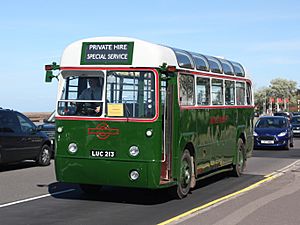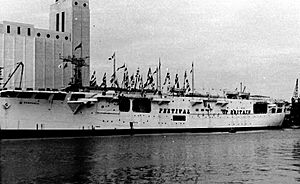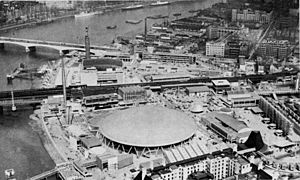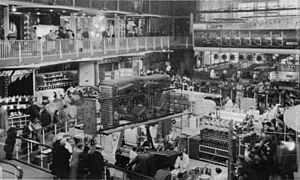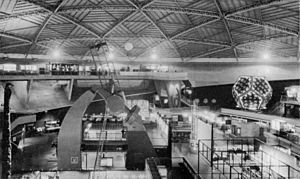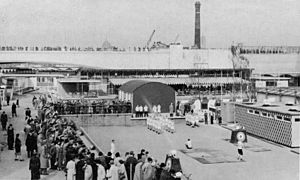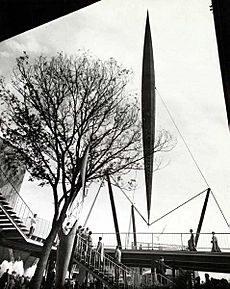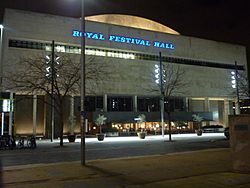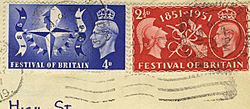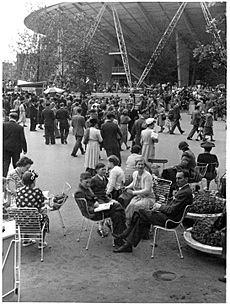Festival of Britain facts for kids
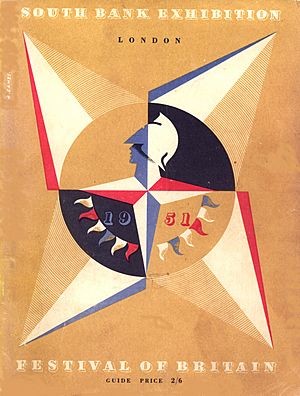
The Festival of Britain was a huge national event held across the United Kingdom in the summer of 1951. It was like a giant exhibition and fair that millions of people visited. Many historians say it was a "triumphant success."
People loved visiting the main site in London, especially the Dome of Discovery and the tall Skylon. There were also smaller festivals all over the country. After years of war and tough times, people were ready to enjoy themselves. The Festival really showed off how creative and clever British scientists, engineers, and artists were.
Labour government minister Herbert Morrison was the main person behind the Festival. He first planned it to celebrate 100 years since the Great Exhibition of 1851. But this wasn't a world fair. Instead, the 1951 Festival focused only on Britain and its amazing achievements.
The government mostly paid for it, spending about £12 million. The Labour government hoped the Festival would make people feel positive about Britain's recovery after the war. It also aimed to promote British science, technology, design, architecture, and arts.
The main part of the Festival was in London on the South Bank of the River Thames. Other events happened in Poplar (showing new architecture), Battersea (fun gardens), and South Kensington (science). There was also a big industrial power exhibition in Glasgow. Many other towns and cities across Britain held their own celebrations and exhibitions.
The Festival became a "beacon for change." It was very popular and helped shape British arts, crafts, designs, and even sports for a whole generation. People called the new look "Contemporary." It was "clean, bright and new" and brought bold, bright colours to an island that used to have mostly dull browns and greens.
Contents
- How the Festival Started and Was Organized
- Main Events and Locations
- The South Bank Exhibition: A Look Inside
- Festival Pleasure Gardens: Fun for Everyone
- Key Aspects of the Festival
- Other Festival Events
- How Many People Visited?
- Political Views on the Festival
- What Lasted from the Festival?
- Images for kids
- See also
How the Festival Started and Was Organized
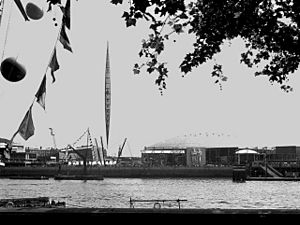
The first idea for a big exhibition in 1951 came in 1943. The Royal Society of Arts thought it would be good to mark 100 years since the 1851 Great Exhibition. In 1945, the government looked into how exhibitions could help Britain sell more goods abroad.
A year later, they decided not to have an international exhibition. It would be too expensive when Britain was still rebuilding after the war. Instead, Herbert Morrison decided to hold a series of displays about arts, architecture, science, technology, and design. He called it the "Festival of Britain 1951."
Morrison wanted the Festival to be non-political. This meant things like national healthcare or working-class housing were not included. Instead, the focus was on town planning, scientific progress, and all kinds of traditional and modern arts and crafts.
Much of London was still in ruins after the war. The Festival aimed to give Britons hope and show progress. It also wanted to encourage better design in rebuilding towns and cities. The Festival called itself "one united act of national reassessment." Gerald Barry, the Festival Director, said it was "a tonic to the nation."
A special Festival Council was set up to advise the government. Herbert Morrison was in charge of organizing everything. He created a Festival Headquarters, which became the Festival of Britain Office. This was a government department with its own budget.
Many other groups helped, like the Arts Council of Great Britain and the Council of Industrial Design. They also created special councils for architecture and science.
Gerald Barry was in charge of the daily operations. He was energetic and good at knowing what people would like. He chose many young architects and designers who had worked together before. They shared similar ideas about society and art, which helped everything run smoothly.
What Was on Display?
The Festival showed off arts through music and plays across the country. New architecture was presented in a new neighbourhood called the Lansbury Estate in Poplar, London.
The main attraction was the South Bank Exhibition in London. It showed how British science, technology, and industrial design had advanced. These displays were shown in a way that connected to everyday life.
Other displays were held elsewhere. The Festival Pleasure Gardens were set up in Battersea, a few miles up the river from the South Bank. Heavy engineering was the topic of an exhibition in Glasgow. Some science topics were shown in South Kensington.
A smaller version of the South Bank story was on the Festival ship Campania. This ship sailed around the coast of Britain all summer. There was also a travelling exhibition of industrial design that went by land.
London Transport even ordered special buses with roof lights. These were used as sightseeing coaches for the Festival visitors.
Main Events and Locations
England
Exhibitions
- South Bank, London (May 4 – September 30)
- Science, South Kensington (May 4 – September 30)
- Architecture, Poplar (May 3 – September 30)
- Books, South Kensington (May 5 – September 30)
- 1851 Centenary Exhibition, South Kensington (May 1 – October 11)
- Festival of British Films, London (June 4 – June 17)
Festival Pleasure Gardens, Battersea Park, London (May 3 – November 3)
London Season of the Arts (May 3 – June 30)
Arts Festivals
- Stratford-upon-Avon (March 24 – October 27)
- Bath (May 20 – June 2)
- Bournemouth and Wessex (June 3 – June 17)
- York (June 3 – June 17)
- Aldeburgh (June 8 – June 17)
- Norwich (June 18 – June 30)
- Cheltenham (July 2 – July 14)
- Oxford (July 2 – July 16)
- Brighton (July 16 – August 25)
- Canterbury (July 18 – August 10)
- Liverpool (July 22 – August 12)
- Cambridge (July 30 – August 18)
- Worcester (September 2 – September 7)
Wales
Pageant of Wales, Sophia Gardens, Cardiff
St Fagan's Folk Festival, Cardiff
Welsh Hillside Farm Scheme, Dolhendre
Arts Festivals
Scotland
Exhibitions
- Industrial Power, Glasgow
- Contemporary Books, Glasgow
- "Living Traditions" – Scottish Architecture and Crafts, Edinburgh
- 18th Century Books, Edinburgh
Arts Festivals
Gathering of the Clans, Edinburgh
Scots Poetry Competition
Masque of St. Andrews, St. Andrews
Northern Ireland
Ulster Farm and Factory, Belfast
Arts Festival
Travelling Exhibitions
Festival Ship Campania,: England, Scotland, Wales and Northern Ireland
- Southampton (May 4 – May 14)
- Dundee (May 18 – May 26)
- Newcastle (May 30 – June 16)
- Hull (June 20 – June 30)
- Plymouth (July 5 – July 14)
- Bristol (July 18 – July 28)
- Cardiff (July 31 – August 11)
- Belfast (August 15 – September 1)
- Birkenhead (September 5 – September 14)
- Glasgow (September 18 – October 6)
Land Travelling Exhibition : England
- Manchester (May 5 – May 26)
- Leeds (June 23 – July 14)
- Birmingham (August 4 — August 25)
- Nottingham (September 15 – October 6)
The South Bank Exhibition: A Look Inside
Building the the South Bank site created a brand new public area. Before, there were just warehouses and old housing. The layout of the South Bank was designed to show off new ideas for city planning after the war. This included buildings with different levels and walkways above the ground. Most buildings were in a modern style called International Modernism, which was new to Britain.
The architecture and displays were planned by a special team. This team included famous designers and architects like Gerald Barry and Hugh Casson.
The main idea for the exhibition was created by Ian Cox.
The exhibition had different parts: the Upstream Circuit ("The Land"), the Dome of Discovery, the Downstream Circuit ("The People"), and other displays.
Upstream Circuit: "The Land"
This section focused on Britain's natural resources and industries. Exhibits included:
- The Land of Britain.
- The Natural Scene
- The Country.
- Minerals of the Island
- Power and Production
- Sea and Ships.
- Transport.
The Dome of Discovery
This huge dome focused on scientific discoveries. Exhibits covered:
- The Land.
- The Earth.
- Polar.
- Sea.
- Sky.
- Outer Space.
- The Living World.
- The Physical World.
Downstream Circuit: "The People"
This part explored British life and culture. Exhibits included:
- The People of Britain.
- The Lion and the Unicorn (about British character and traditions).
- Homes and Gardens.
- The New Schools.
- Health.
- Sport.
- Seaside.
Other South Bank Displays
- Television.
- Telecinema. This special cinema showed new kinds of films.
- The 1851 Centenary Pavilion.
- Shot Tower.
- Design Review.
Special Features of the South Bank Exhibition
The Skylon
The Skylon was a very unusual, cigar-shaped tower. It was a lasting symbol of the Festival. The base was about 15 meters (50 feet) off the ground, and the top reached almost 90 meters (300 feet) high. It was made of a steel frame covered in aluminium. At night, it glowed from lights inside.
It was designed by Hidalgo Moya, Philip Powell, and Felix Samuely. The Skylon was taken down in 1952 by order of Winston Churchill. He saw it as a symbol of the previous Labour government.
Royal Festival Hall
The Royal Festival Hall was designed by Leslie Martin, Peter Moro, and Robert Matthew. It was built for the London County Council. The first stone was laid in 1949. The building officially opened on May 3, 1951. It was designed to keep out noise and vibrations from the nearby railway. In 1988, it became a Grade I listed building, meaning it's a very important historic building.
Festival Pleasure Gardens: Fun for Everyone
The Festival Pleasure Gardens were made to show a lighter, more fun side of the Festival. They were built in Battersea Park, a few miles from the South Bank. Attractions included:
- An amusement park with rides like the Big Dipper. This park stayed open until the mid-1970s.
- A miniature railway designed by Rowland Emett.
- A "West End" Restaurant with a view of the river.
- Foaming Fountains.
- A wine garden with small pavilions.
- A wet weather pavilion for performances, even in the rain.
- An amphitheatre that could seat 1,250 people.
Most of the buildings in the gardens were designed by John Piper. There was also a fun Guinness Festival Clock. The Pleasure Gardens were just as popular as the South Bank Festival. They stayed open longer than the rest of the Festival because they were so popular.
Key Aspects of the Festival
Architecture and Design
The Festival architects wanted to show what modern town planning could achieve. The "Festival Style," also called "Contemporary," mixed modern ideas with a bit of British charm. This style influenced architecture, interior design, and product design in the 1950s.
It featured things like "Braced legs, indoor plants, aluminium lattices, picture windows, flying staircases, blond wood." This style was seen in new towns and buildings like Harlow and the rebuilt city centre of Coventry. Coventry Cathedral (1962), designed by Basil Spence, was even called "The Festival of Britain at Prayer."
There was an exhibition about building and town planning in the Lansbury Estate in Poplar. This area had been badly damaged in the war. The exhibition showed new housing and town planning ideas. Visitors could see how new towns might look.
While the South Bank exhibition was very popular, the Poplar architecture exhibition had fewer visitors. Some experts thought the designs weren't very new. However, the Festival did introduce modern architecture to a wider audience.
The South Bank Exhibition also had a "Design Review." This showed off the best of British industrial design. It promoted "Good Design," which meant products were chosen for their looks, quality, and usefulness. This idea came from the "utility furniture" made during the war.
Science and design came together in the Festival Pattern Group. This group used patterns from x-ray crystallography (which shows the structure of molecules) for textiles, wallpaper, and other items. For example, the Regatta Restaurant used patterns based on the structure of haemoglobin and insulin. This linked design to the Festival's focus on science and technology.
The lettering and typefaces used in the Festival were also very important. A special typeface called Festival Titling was created. The lettering on the Royal Festival Hall was bold and modern. The graphic designer for the Festival was Abram Games, who created the famous Festival Star emblem.
The Arts at the Festival
The South Bank Exhibition featured works by modern artists. This included murals by Victor Pasmore and sculptures by Henry Moore and Barbara Hepworth.
Many arts festivals were held across the country during the summer:
- Aberdeen Festival
- Aldeburgh Festival of Music and the Arts
- Bath Assembly
- Belfast Festival of the Arts
- Bournemouth and Wessex Festival
- Brighton Regency Festival
- Cambridge Festival
- Canterbury Festival
- Cheltenham Festival of British Contemporary Music
- Dumfries Festival of the Arts
- Inverness 1951 Highland Festival
- Liverpool Festival
- Llangollen International Eisteddfod
- Llanrwst (Royal National Eisteddfod of Wales)
- Norwich Festival
- Oxford Festival
- Perth Arts Festival
- Stratford-upon-Avon (Shakespeare Festival)
- St David's Festival (Music and Worship)
- Swansea Festival of Music
- Worcester (Three Choirs Festival)
- York Festival (including a return of the York Mystery Plays)
London also had its "Season of the Arts." This included exhibitions like "60 Paintings for '51" and shows of works by Hogarth and Henry Moore. There was also an open-air sculpture exhibition in Battersea Park.
An interesting exhibition called "Black Eyes and Lemonade" showed British popular and traditional art. This included things like taxidermy, fairgrounds, and canal boat decorations.
The Festival was also the first time steelpan music was performed in Britain by the Trinidad All Steel Percussion Orchestra.
Film and the Festival

The British Film Institute helped plan how films could be part of the Festival. Over a dozen documentary films were made, such as "Family Portrait" and "David."
Only one feature film, The Magic Box, was ready in time. It was a film about the film pioneer William Friese-Greene.
A special cinema called the Telecinema was built on the South Bank. It showed documentaries and experimental films using new sound and 3D technology. It was one of the most popular attractions, with over 450,000 visitors. After the Festival, it became the National Film Theatre.
Films were also used throughout the South Bank Exhibition to explain science and technology. Film festivals in Edinburgh, Bath, and Glasgow also took part. Even regular cinemas showed British films.
The British Broadcasting Corporation also contributed with a television musical called The Golden Year.
Science at the Festival
A new part of the Science Museum was built for the Exhibition of Science. This exhibition showed the basic nature of matter and how elements and molecules behave. It also covered plants and animals, and the latest research topics. These included things like rays from outer space and how the electronic brain works.
Some people believe the Festival of Britain caused confusion about how important science should be in British life and education.
Other Festival Events
Hundreds of other events happened during the Festival. Some examples include:
- The village of Trowell in Nottinghamshire was chosen as the Festival Village.
- Parliament Square in London was redesigned.
- Special postage stamps and many souvenirs were made.
- A special crown coin was minted. It had the St. George and the Dragon design.
- The Moot Hall, Elstow was restored.
- The first performance of Robert McLellan's play Mary Stewart in Glasgow.
- The first performance of Ralph Vaughan Williams's opera The Pilgrim's Progress.
- An exhibition about Sherlock Holmes.
- Special excursion trains, The William Shakespeare and The Merchant Venturer, ran from London to historic sites.
How Many People Visited?
The Festival was very popular across Britain. About half of the country's population of 49 million people took part. Most visitors were from Britain, with fewer foreign tourists.
Over 10 million paid tickets were sold for the six main exhibitions over five months. The South Bank Exhibition was the most popular, with almost 8.5 million visitors. More than half of these visitors came from outside London. The Festival Pleasure Gardens had over 8 million visitors.
The Festival Ship Campania visited ten cities and was seen by almost 900,000 people. The Travelling Land Exhibition went to four English cities and attracted nearly half a million visitors.
The architecture exhibition in Poplar and the books exhibition in South Kensington had fewer visitors.
| Architecture Exhibition, Lansbury, Poplar (London) | 86,646 |
| Industrial Power Exhibition, Glasgow | 282,039 |
| Science Exhibition, South Kensington (London) | 213,744 |
| South Bank Exhibition, Waterloo (London) | 8,455,863 |
| – Visitors from London | 36.5% |
| – Outside London | 56% |
| – Overseas | 7.5% |
| – USA | 15% |
| – Commonwealth | 32% |
| – Europe | 46% |
| – Elsewhere | 7% |
| Land Travelling Exhibition | 462,289 |
| – Manchester | 114,183 |
| – Leeds | 144,844 |
| – Birmingham | 76,357 |
| – Nottingham | 106,615 |
| Festival Ship Campania | 889,792 |
| – Southampton | 78,683 |
| – Dundee | 51,422 |
| – Newcastle | 169,511 |
| – Hull | 87,840 |
| – Plymouth | 50,120 |
| – Bristol (Avonmouth) | 78,219 |
| – Cardiff | 104,391 |
| – Belfast | 86,756 |
| – Birkenhead | 90,311 |
| – Glasgow | 93,539 |
| Festival Pleasure Gardens, Battersea (London) | 8,031,000 |
| – Visitors from London | 76%, |
| – Outside London | 22% |
| – Overseas | 2% |
| Ulster Farm & Factory Exhibition, Belfast | 156,760 |
| Living Traditions Exhibition, Edinburgh | 135,000 |
| Exhibition of Books, South Kensington (London) | 63,162 |
Political Views on the Festival
The idea of the Festival became a political topic. Even though Herbert Morrison said it shouldn't be political, it became linked to the Labour Party, which was in power. The Conservative Party was against it. Winston Churchill, a Conservative leader, even called it "three-dimensional Socialist propaganda."
Some Labour government members thought the Festival would help them win future elections. However, Labour lost the election in autumn 1951. Churchill's dislike for the Festival led him to order the South Bank site to be cleared as soon as he became Prime Minister.
What Lasted from the Festival?
The Festival's guide book said it would leave behind "a reminder of what we have done to write this single, adventurous year into our national and local history."
The government and London County Council had already planned to redevelop the South Bank site. The Festival helped speed up this process. The Royal Festival Hall was the first big building to be built there. Over the next 30 years, the Festival site became the South Bank Centre, a major arts complex. This includes the Royal Festival Hall, the National Film Theatre, and the National Theatre.
An office building in London, designed in 1951, still has images of the Festival on its outside.
The Festival cost about £10.5 million and brought in about £2.5 million. The final cost to the government was £8 million.
The Festival also created new traditions. For example, the performances of medieval mystery plays in York and Chester became very popular. These plays have been performed regularly in those cities ever since.
In 2018, Prime Minister Theresa May announced plans for a new "Festival of Great Britain and Northern Ireland" for 2022. This proposed festival was meant to unite the UK after Brexit. However, it faced criticism because it would happen during the 100-year anniversary of the Irish Civil War.
Images for kids
Many images of the South Bank Exhibition are available online. The National Archives released many photos on the Festival's 60th anniversary.
A film called Brief City (1952) looked back at the South Bank Exhibition, focusing on its design and architecture. A comedy film, The Happy Family, was made about people who didn't want their homes demolished for the Festival. The Festival also appears in the film Prick up your Ears.
The University of Brighton Design Archives has hundreds of images of the Festival. You can search for them online.
See also
- Britain Can Make It, an exhibition from 1946
- The Great Exhibition, from 1851
- World's fair
- List of world's fairs
- Saint Mungo Cup, a football tournament in Glasgow held during the Festival
- Millennium Dome


